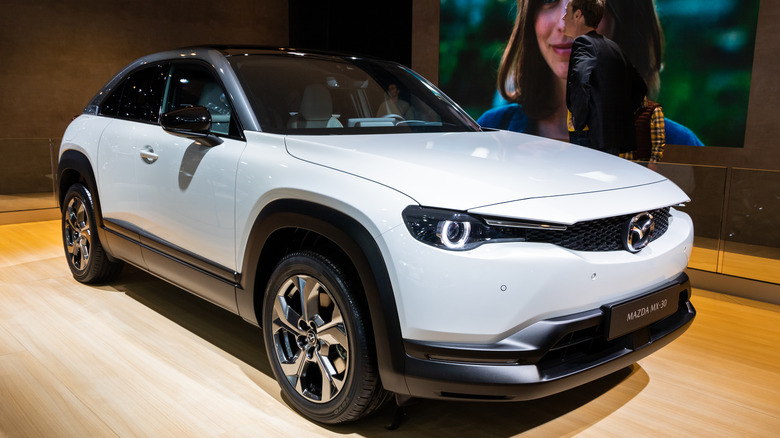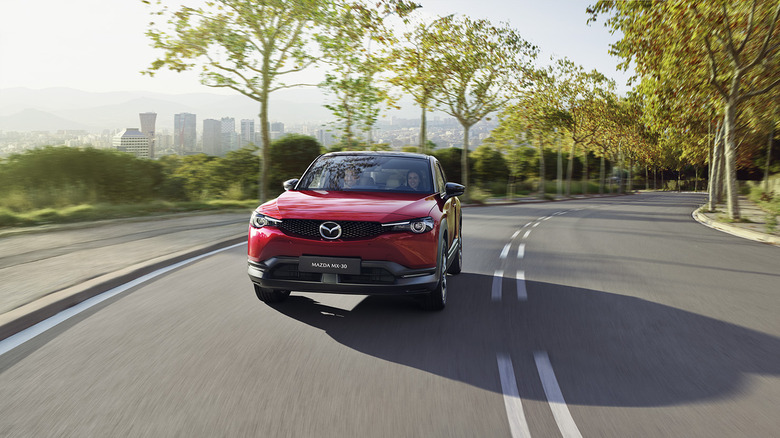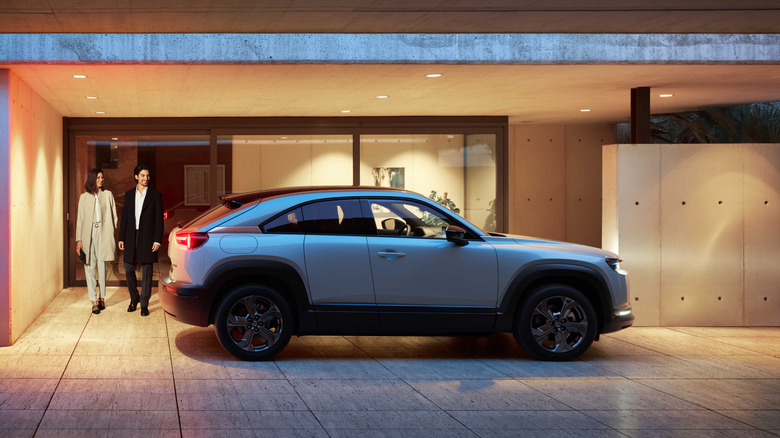The Hotly-Anticipated Mazda That Just Isn't Delivering
Mazda unveiled the MX-30 in 2020 as the Japanese automaker's first production EV. Mazda also promises to eventually launch an MX-30 plug-in hybrid variant equipped with a rotary gas engine range extender. For those who don't closely follow the brand, Mazda fancies rotary engines that produce oodles of power (and smoothly revs to the redline like it's running on butter) despite inherent problems with its apex seals. But in the MX-30, the rotary gas engine will function strictly as a generator to replenish the battery pack and would not drive the front wheels directly.
Being a Mazda, you can bet there's that sporty driving feel inherent to all Mazda production vehicles. The MX-30 is perhaps one of the most hotly-anticipated new Mazdas in recent memory, but it seems not a lot of potential buyers were smitten by its zero-emissions charm. It's hard not to talk about the Mazda MX-30's stylish body style with fashionable (yet sometimes impractical) rear doors that are similar to what's found in the RX-8 sports car. But many drivers have been disappointed with the vehicle's limited range.
Mazda MX-30: Minimal range means dismal sales figures
Mazda's most recent press release noted that despite selling 6,040 CX-30s last July, its top sales report for the vehicle, Mazda North America only sold 23,393 cars in the same period, a decrease of 28.5% compared to July 2021. If you look closer at the numbers, Mazda only sold eight units of the MX-30 last July, and only 324 units left the factory in the first six months of 2022. We think we know why this is so.
First, the Mazda MX-30 has a 35.5 kWh battery that only achieves an EPA-estimated 100 miles of range, which is not a lot considering its $34,695 base price (per Car and Driver). Equipped with a modest 143-horsepower front-mounted electric motor, the MX-30 doesn't feel as quick or eager as offerings from domestic makers like the Ford Mustang Mach-E or Chevy Bolt.
On the charging side, the MX-30 supports up to 50 kW DC fast charging, enough to replenish the batteries from 0 to 80% in about half an hour. It's good enough, but it pales compared to other EVs that support a minimum of 150 kW of DC fast charging. The saving grace is the standard 6.6 kW onboard charger that could re-juice the batteries from 20% to 80% in about three hours using a 240-volt Level 2 power source.
Cozy interior
On the inside, the Mazda MX-30 has its fair share of both merits and complaints. The front row has decent room and spoils occupants with premium materials and classy detailing. However, the second row has less rear legroom than a two-door sports coupe and is only ideal for kids or near-adolescents (per Edmunds).
Moreover, the MX-30 has no frunk or front trunk like many EVs, but it does offer 21 cubic feet of cargo room behind the rear seats, which is among the roomiest among new compact EVs. For the money, the MX-30 comes with great and desirable standard features like adaptive & swiveling LED headlights, 18-inch wheels, a digital instrument cluster, an 8.8-inch infotainment touchscreen, power & heated front seats, automatic climate control, and an eight-speaker audio system with Apple CarPlay and Android Auto connectivity. It also comes with advanced safety technologies like adaptive cruise control, lane departure warning, blind-spot monitoring, rear automatic braking, and rear parking sensors. Still, that's not enough to make buyers rush to Mazda dealerships to part with their hard-earned cash.
Volkswagen's new ID.4 electric SUV in Standard trim starts at $37,495 before tax credits (per ReviewGeek), less than the $37,655 base price of a range-topping Mazda MX-30 Premium Plus, and the VW has a larger battery (62 kWh), more range (an estimated 208 miles per full charge), room for five adults and cargo, and up to 170 kW DC fast charging capability. Small wonder why not many buyers are looking forward to adding a Mazda MX-30 to their garage.





